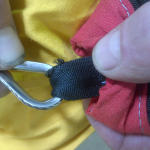Welcome to the first of what may become a regular item on the website. Many years ago we started a thing called Inspectors Info, the copies of which I think may still be available on the BBAC website and is still issued occasionally by the BBAC Technical Office under the fine auspices of Graham Hallett, however it was always in the Inspectors’ domain. We think it’s a good idea to share this sort of stuff with everyone so if you find a problem, however basic or serious (or both), please let us know and, where appropriate, how the manufacturer dealt with the problem. If you can, please send some piccies as well. So that implies that is not confined to inspectors but to all and in the unlikely event you wish to remain anonymous, we’ll respect that.
Cameron big fat 45mm vertical load tapes
 So there we were once again chatting about this and that and rows of stitching, like you do, and we got onto the subject of the 45mm vertical loadtapes used on the big ride balloons whereupon we disagreed about the number of rows of stitches required on the turnback. “Its always been 16,” pronounced John, “that’s what I do.” I wasn’t so sure so out came Cameron’s Maintenance Manual Issue 10-3 and off we trotted to 2.3.3.2 whereupon it stated ‘8 rows’. We phoned Andy at Camerons who reckoned it was 16 and would look into it. A few days later dear old long-suffering Craig dropped us this note;
So there we were once again chatting about this and that and rows of stitching, like you do, and we got onto the subject of the 45mm vertical loadtapes used on the big ride balloons whereupon we disagreed about the number of rows of stitches required on the turnback. “Its always been 16,” pronounced John, “that’s what I do.” I wasn’t so sure so out came Cameron’s Maintenance Manual Issue 10-3 and off we trotted to 2.3.3.2 whereupon it stated ‘8 rows’. We phoned Andy at Camerons who reckoned it was 16 and would look into it. A few days later dear old long-suffering Craig dropped us this note;
‘Just a quick email to say that we had a test house pull several samples of 45mm load tape turn back assemblies, some made with 8 parallel rows of stitching and some made with 16 rows of parallel stitching and the outcome was very reassuring. The 8 row samples broke around 3.4 tonnes compared to the 16 row samples at 3.25 tonnes which is 500kg higher than the minimum design strength we require for 45mm load tape assemblies. All the samples broke outside of the stitched assembly, due to the way that the samples were held in the test rig, so the turn backs would have achieved a higher break load if the test house could have located the  sample better. So the test results have confirmed that there is no immediate airworthiness issue but thanks for pointing out the error in our maintenance manual. We do intend to change back to the 16 rows specification as the additional 8 rows probably offers a bit more piece of mind should a wayward burner flame get too close to the turn back stitching.’
sample better. So the test results have confirmed that there is no immediate airworthiness issue but thanks for pointing out the error in our maintenance manual. We do intend to change back to the 16 rows specification as the additional 8 rows probably offers a bit more piece of mind should a wayward burner flame get too close to the turn back stitching.’
So there you have, don’t fail repairs to 45mm tape if there are only eight rows of vertical stitching as that number is understandably stronger than 16. With eight rows 3.25 tonnes per tape is quite sufficient but 16 rows give a better redundancy so repair using 16 and the Manual will be updated in due course.
PRVs – Two is not better than one
 Two Pressure Relief Valves (PRVs) in one cylinder are still turning up so people are still fitting a second PRV when the second goes out of date. Naughty people. This is because the one going out of date is likely to be one built into the vapour valve and the replacements are rather expensive to say the least. Simple solution then is to leave the built-in one there so you still have a master and stuff a new one in the PRV hole. There isn’t actually that much difference in cost if you replace the vapour valve with a non-PRV type and fit a PRV. The other scenario is when a slave gets converted to a master and for some reason a secondhand vapour valve with a built-in PRV is fitted! Yes it really is happening. Cylinders should only be fitted with one PRV.
Two Pressure Relief Valves (PRVs) in one cylinder are still turning up so people are still fitting a second PRV when the second goes out of date. Naughty people. This is because the one going out of date is likely to be one built into the vapour valve and the replacements are rather expensive to say the least. Simple solution then is to leave the built-in one there so you still have a master and stuff a new one in the PRV hole. There isn’t actually that much difference in cost if you replace the vapour valve with a non-PRV type and fit a PRV. The other scenario is when a slave gets converted to a master and for some reason a secondhand vapour valve with a built-in PRV is fitted! Yes it really is happening. Cylinders should only be fitted with one PRV.
Kubicek Parachute Loops
 We recently had The Packhouse Kubicek balloon, G-PHSE, in for its first inspection and found damage to some of the parachute loops. Now the owner and chief pilot have never been that impressed with the fuel consumption so at about 20 hours brought it over to have the overlap checked. We measured it up and it was quite apparent that the velcros on the envelope and parachute were meshing even after being cleared. Kubicek arranged for the parachute to be readjusted under warranty and it duly was. 20 or so hours later it had its first annual inspection. Mouseholes the Pilot, sipping his nettle and dandelion tea, told us it was still a thirsty old thing and during the course of the inspection we found that some of the parachute rigging lines from the envelope to the parachute loop had actually started to abrade the loops. We re-measured the overlap and the velcros were still fouling after being apparently cleared. Clearly things were amiss and we failed the balloon as the damage had clearly occurred just over 20 hours after it was first adjusted and another 100 hours would certainly have seen failure of the loops. It certainly wasn’t there the first time we looked at it and the adjustment hadn’t caused it as the lines still all measured pretty much the same. After informing us that even if half the loops had failed it would still have been OK Kubicek eventually took the envelope back and have informed us that they have now replaced the loops and re-rigged the parachute. They have also offset the velcros as other manufacturers now do.
We recently had The Packhouse Kubicek balloon, G-PHSE, in for its first inspection and found damage to some of the parachute loops. Now the owner and chief pilot have never been that impressed with the fuel consumption so at about 20 hours brought it over to have the overlap checked. We measured it up and it was quite apparent that the velcros on the envelope and parachute were meshing even after being cleared. Kubicek arranged for the parachute to be readjusted under warranty and it duly was. 20 or so hours later it had its first annual inspection. Mouseholes the Pilot, sipping his nettle and dandelion tea, told us it was still a thirsty old thing and during the course of the inspection we found that some of the parachute rigging lines from the envelope to the parachute loop had actually started to abrade the loops. We re-measured the overlap and the velcros were still fouling after being apparently cleared. Clearly things were amiss and we failed the balloon as the damage had clearly occurred just over 20 hours after it was first adjusted and another 100 hours would certainly have seen failure of the loops. It certainly wasn’t there the first time we looked at it and the adjustment hadn’t caused it as the lines still all measured pretty much the same. After informing us that even if half the loops had failed it would still have been OK Kubicek eventually took the envelope back and have informed us that they have now replaced the loops and re-rigged the parachute. They have also offset the velcros as other manufacturers now do.  We await its return and re-inspection. It would be worth having a chat to owners of Kubicek envelopes to see what their fuel consumption really is and whether or not the velcros foul after being cleared.
We await its return and re-inspection. It would be worth having a chat to owners of Kubicek envelopes to see what their fuel consumption really is and whether or not the velcros foul after being cleared.
Providing the velcros are not resealing than damage to parachute loops is probably a mix of abrasive rigging lines and hardening of the loop through heat. If the velcros reseal then during flight any movement or distortion of the envelope during climbing or descending will cause tension in the envelope to parachute rigging lines which could lead to the loops being abraded.
There is one other thing that can cause damage to loops and that is muppetry when pulling the parachute out of the envelope during rigging especially if the rigging lines are used or the parachute is tangled in the envelope. The advice to the owner should be to allow the air to part inflate the envelope before trying to pull the parachute up the balloon. If resistance is felt then be patient and free the parachute, rigging lines and ripline first. If the cause of the problem is not obvious and the balloon is still on relatively low hours we would recommend, in all cases, referring it back to the manufacturer or their agent.
Cameron Lightweight Concept flying wire loops
While we are on about damage to tapes, this was a strange one and we couldn’t really find any reason for it at  all and when it went back to Camerons nor could they but they did replace all the turnbacks. This type of damage is usually caused by damaged or sharp edges on the flying wire eyelets. Ultramagic issued a Service Bulletin 01/03 back in 2003 when a faulty batch of eyelets were starting to abrade the loops. In the case of the Cameron problem it did appear to be isolated and we couldn’t find any evidence of sharp edges or damage to the eyelets. Perhaps it was the type of tape being used but as no more incidents seem to have been reported we can’t be sure.
all and when it went back to Camerons nor could they but they did replace all the turnbacks. This type of damage is usually caused by damaged or sharp edges on the flying wire eyelets. Ultramagic issued a Service Bulletin 01/03 back in 2003 when a faulty batch of eyelets were starting to abrade the loops. In the case of the Cameron problem it did appear to be isolated and we couldn’t find any evidence of sharp edges or damage to the eyelets. Perhaps it was the type of tape being used but as no more incidents seem to have been reported we can’t be sure.